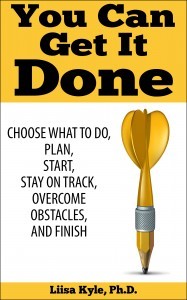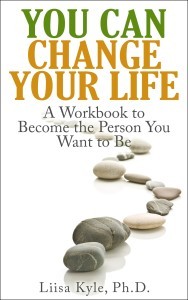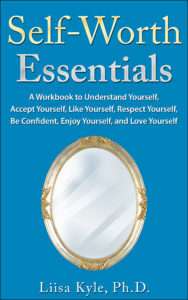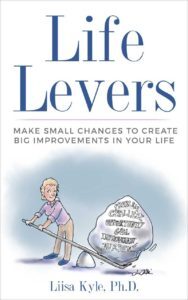Liisa Kyle's Blog, page 2
December 1, 2024
Make the Most of 2025
What would you like to do with 2025?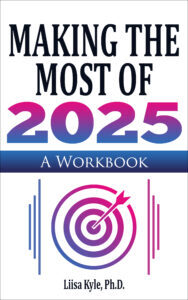
Some people like to set specific goals for the New Year. Others prefer to give some general attention to a particular area of their life. Keith’s priority in 2025 is to focus on his health. Maria’s is to relax. Maybe you’d like to travel. Or learn. Or create. Or do good deeds. Perhaps you’d like this to be the “Year of Fun”. Maybe you’ve been overly career driven and this is the year you’ve like to give more attention to your home life.
It’s entirely up to you: What would you like to experience this year? What’s important to you? What would you like to explore or learn? What would you like to accomplish, acquire, or complete?
The beginning of a New Year is a terrific time to pause and ask yourself these questions. New Year’s Eve is more than just a festive excuse to party…it’s a chance for a fresh start. Kinda like pressing a personal “re-start button.” If you choose to do so, you can use the opportunity to look back at the preceding year and take stock of your present circumstances. You can identify what’s working well for you and what’s not. You can make thoughtful, purposeful decisions about how to live the next twelve months. With a little forethought, New Year’s Eve can be a pivot point to do more of what you love and less of what you don’t.
If this sounds appealing, I’ve developed a workbook to guide you through a process to make the most of the coming year. It’s completely up to you: What would you like to do, experience, explore, learn, accomplish, acquire, or complete in 2025?
Note the emphasis on you. You. Not what your Mom or your boss or your childhood chum might want. What kind of year would you like 2025 to be? What matters to you at this point in your life?
What would it mean to you if you made the most of 2025?
Whatever your desires for 2025, I can help. I’m an author, life coach, and Ph.D. in Psychology who has spent the past twenty years helping people get things done, get organized, and get more out of life. I’ve coached individuals, facilitated groups, and taught inventive workshops on four continents.
I’ve designed this book so you can get the most out of 2025. Think of it as a personal seminar with a recognized expert, tailored to your unique circumstances and preferences. Inside this workbook are proven tools you can work through at your own pace to foster whatever is important to you.
That’s what makes this book special. It’s a flexible guide that will elicit different responses in everyone who uses it. It’s up to you to apply your distinctive perspective to create and implement a plan suitable to your particular circumstances.
Think of it as a Self-Guided Workshop you can work through at your own pace to:
understand and appreciate 2024generate ideas for all areas of your lifeidentify your true top priorities for 2025make achievable plans for 2025keep yourself on track all yearA Word About “Resolutions”
The way most people do traditional “New Year’s Resolutions” is not very effective. They tend to be overblown “To Do” lists that become a source of unnecessary frustration. They can be overwhelming or intimidating. They often become abandoned which can cause guilt, shame, and a sense of failure.
The alternative is to create a prudent plan that can be reasonably implemented, given your specific circumstances. That’s the purpose of this workbook.
If you’ve been disappointed by past attempts at “New Year’s Resolutions”, let me reassure you. As a life coach, I’ve developed proven techniques for you to figure out what you want and then devise achievable plans to make that happen.
Maybe you’d like to set some specific goals. Perhaps you’d like to solve a problem. Or participate in some key activities to enhance your life. Or establish new habits or practices that are uniquely gratifying to you. It could be that you have an unfulfilled dream or an unfinished project on which you are yearning to make some progress. Maybe you’d like to reduce or eliminate an unhelpful or unhealthy habit.
It’s up to you. Using this workbook as a guide, you have the opportunity to figure out what’s right for you, right now, to make the most of 2025 — then devise achievable plans suitable to your particular circumstances. The Planner/Calendar is designed to help you actually do what you intend.
Give yourself — or someone else — the give of a wonderful 2025. Hardcover, paperback & eBook formats available here:
November 1, 2024
Do You Think Too Much?

By AndrewHorne [Public domain], from Wikimedia Commons
Thinking is good. It’s essential to creativity: Thinking lets us conjure ideas and products would of thin air, devise solutions to problems, and put things together in novel ways. Alas, like many good things, there’s a risk of overdoing it. Especially for DaVincis — people juggling many ideas, projects and talents.One problem: it’s easy for our Monkey Minds to hop around erratically from thought to thought, from project to project, from ‘the task at hand’ to any number of procrastinating activities. This can disrupt our focus and our progress by scattering our efforts in random ways.
Another cost of over-thinking: we can over-complicate things. It’s ridiculously easy for us to create great drama out of simple situations. We can generate a thousand ‘what if’s’ and complications for any scenario…none of which are very likely or relevant. We can think of convoluted rationalizations to talk ourselves into — or out of — things we shouldn’t. We can see problems where there really aren’t any. We can get sucked into a never-ending loop of activity, aiming for an unrealistic level of perfection.
And then there’s the impact our overthinking has on others. The way our brains function can be bewildering, or intimidating, or annoying to those around us. We can introduce new information or options at a time when it doesn’t seem relevant to the task at hand. We can ‘download’ and share too many ideas at once, making others confused or uncomfortable or confused. We can inadvertently squash other people’s ideas because they assume we’ve already thought of it.
Without meaning to, we can push people away. They may not want to disturb us or challenge us in the midst of a brainstorm. We can give off a negative vibe. Women who think too much risk “Resting Bitch Face” — looking angry when we’re really not. This occurs when the wheels are turning happily in our brains and we’re not aware of the position of our facial muscles. It’s not fair, but our society is such that if your face looks tense or serious or the corners of your mouth aren’t up, people may assume you are unhappy or negative or unpleasant and interact with you, accordingly.
Alas, there are costs to our oh-so-active minds. So what’s an overthinking DaVinci to do?
1. Be aware.
Be attentive to what you are experiencing. If something feels unnecessarily fraught or difficult or complicated, pause and take stock. Ask yourself: Am I overthinking this?
2. When possible, simplify.
There are many, many roads to Rome. If something seems over-complicated — if you’re mired in too many details and options — ask: Is there a simpler or easier way forward?
3. Train your Monkey Mind.
You don’t have to be held hostage by the thought pinging around your brain. You can learn to control and manage your thoughts through techniques such as meditation. It can be as quick and easy as pausing two or three times a day for less than five minutes to simply “be.”
4. Capture and manage your ideas.
What are simple, easy ways you can capture your thoughts and ideas as you go through your day? On paper — in a small notebook, index cards or post-its? Digitally — in your computer, tablet, organizer or phone? Tape recorders and voice mailboxes also work great – and are especially useful for musicians, singers and composers to capture auditory ideas. When you get in the habit of capturing and saving your ideas, you know they are safe — and you tend to generate more and better ideas.
If you are working on something and new thoughts arise, you can capture them, then ‘park’ them for later so you’re not distracted from the task at hand.
5. Watch for cues from others.
Be attentive to the impact of your Monkey Mind on people around you. They may well love your contributions…but there’s a probably a limit. Reel in the need to express every thought, idea, and option that crosses your cranium. Edit what you share and how you share it.
6. Help like-minded others.
When you notice someone else is over-thinking or over-complicating things, ask if there’s an easier or simpler alternative. Together, your Monkey Minds can no doubt generate countless other options.
***
Question: What do you notice when your Monkey Mind is active? What kinds of things do you do? What triggers you to over-think things? What kinds of things do you do or experience when you overthink things? What do you notice in the people around you when you over-think or over-complicate things?
Question: Think of a specific instance when you over-complicated a situation. What happened? How did you feel? What were the consequences?
Thinking back on it now, what might have been a simpler way forward?
Question: What are the simple, easy ways you can capture and manage your ideas on a regular, ongoing manner?
***
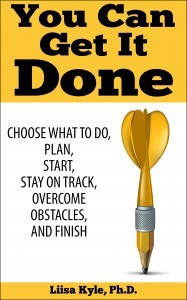 Want more tips and techniques on getting things done? Check out my book YOU CAN GET IT DONE: Choose What to do, Plan, Start, Stay on Track, Overcome Obstacles, and Finish
Want more tips and techniques on getting things done? Check out my book YOU CAN GET IT DONE: Choose What to do, Plan, Start, Stay on Track, Overcome Obstacles, and Finish
Available here for only $3.99: http://bit.ly/YouCanGetItDone
***
Want to re-publish this article? Go for it – just include the author’s name, a link to this original post and the following text blurb:
Are you struggling with too many talents, skills, ideas? You may have The Da Vinci Dilemma
! Find tools, fun quizzes, coaching, inspiration and solutions for multi-talented people at http://www.davincidilemma.com/.
October 1, 2024
Stuck? Unproductive? Wasting Time? Try Quotas
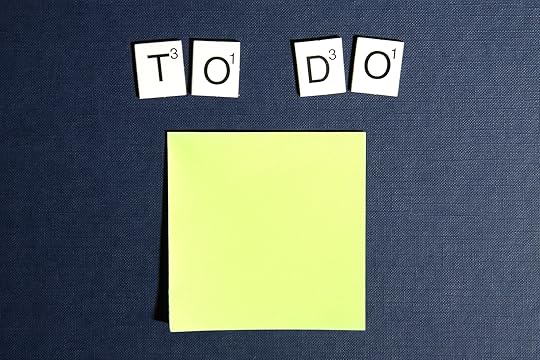
CCO creative commons image via pexels.com
Are you stuck? Is motivating yourself a challenge? Are you procrastinating or wasting time or otherwise NOT doing what you intend? Maybe you are chipping away at some task…but doing so unproductively or less effectively than you’d like. If you haven’t done so recently, you may wish to revisit the notion of “quotas” — of assigning yourself a minimum amount of tasks to be completed within a given amount of time.
For example, many writers commit to a daily minimum of words or page written. Business people may aim for a certain number of cold calls or new clients per week or per month. Dancers, musicians, and athletes may set goals for certain amounts of specified training or practice on each day of each week.
One reason quotas can be especially effective for DaVincis – smart, creative people juggling several talents, projects and ideas — is that quotas provide a very light structure to support and enhance creativity. It’s simple guiding notion — rather than a complex, oppressive, 9-to-5 prison.
Quotas can motivate you do get things done — while still providing you with flexibility in how or when you do so. For example, if I commit to write (at least) four articles a week, I can do them whenever I want, fitting them in among whatever else my week holds. It doesn’t matter what arises in work or any other life domain . . . as long as a minimum of four pieces are filed by end of day Friday.
Besides flexibility, another upside is that quotas tend to specific a ‘minimum’. Once you accomplish your intended goal, it’s intrinsically gratifying. As a bonus, if you choose to, you can do more, which can feel even better. In fact, my coaching clients often find it more motivating to assign a conservative quota that it is relatively easy…and oh so pleasant…to achieve, in part because it often stimulates them to do more — to exceed their minimum target.
Quotas have other benefits as well.
They can ensure you are actually participating in the things you wish to do. Just as they work for professional activities, they also can work for other areas of life. If you are looking to improve your nutrition, you could make a point of eating a salad every day. If you love to read, why not aim to read a book a week or a month (or whatever rate make sense your life situation)? If you love being outdoors but notice it’s been weeks since you did so, establishing a minimum ‘time outside’ target can ensure you don’t let this simple pleasure slip get forgotten amid everything else you’re doing.
It’s up to you to decide what’s important.
***
Activity: What would you like to be doing more of? What are you not doing enough of? Make a list. Now, for each item on your list, ask yourself: what would be an appropriate target quota to aim for, given your life circumstances these days?
***
Also consider that quotas can motivate you to tackle activities that are less enjoyable but necessary. For example, if you don’t like housework, you could set a minimum amount of time per day or per week to your chores. It’s surprising what you can get done in even fifteen minutes a day. Alternatively, you could create a realistic list of minimum ‘to do’ tasks for the week.
When tackling things you don’t enjoy doing, it’s important to choose the smallest, easiest, more conservative quota possible. If your target is too ambitious, you won’t do it and you’ll feel worse about it. If in doubt, aim for less.
***
Activity: What necessary activities do you find it difficult to make yourself do? Make a list. Now, for each item on your list, ask yourself: what would be the smallest, easiest, most conservative target quota you could aim for, given your life?
***
Along the same lines, quotas are great for starting new healthy habits.
For best results, being with laughably small targets. For example, let’s say you don’t like to exercise but would like to start. Rather than beginning by committing to run for thirty minutes every day, why not start with something you KNOW you can do — and that you know you WILL do — such a walking at least six minutes a day. Start with that. When you do this reliably for, say, a week, you might replace one minute of your walking with one minute of running. Gradually, as you experience success meeting a particular quota, you could increase the challenge a titch. If you did so, it wouldn’t take that long before you were, actually, running for thirty minutes a day, three times a week.
***
Activity: What healthy habits would you like to start? Make a list. Pick whichever of these is most important or most interesting for you right now. Now, ask yourself: what would be a laughably easy way to begin?
***
Quotas can also curtail unhelpful or unhealthy behaviors.
If you are an internet junkie, for example, you can use quotas to help you shift your habit. You could limit your internet surfing to, say, 30 minutes per day. This gives you permission to indulge but prevents you from over-indulging.
***
Activity: What unhealthy or unhelpful habits do you have? What would you like to be doing less of? Make a list. Pick whichever of these is most important or most detrimental for you right now. Now, ask yourself: what would be reasonable new limit on this activity? What target quotas can you commit to?
***
Quotas can be reinforced and enhanced with rewards.
While meeting quotas in intrinsically gratifying, you can solidify your preferred behavioral patterns by rewarding yourself whenever you meet your quotas. This is especially true if you are using quotas to curtail an unwanted behavior: I strongly suggest you reward yourself for each and every successful accomplishment along the way.
The challenge with rewards, however, is that many of us have a hard time actually treating ourselves. It’s up to you to identify what are fitting, pleasant, reasonable, do-able rewards for meeting your target. It doesn’t work if you promise yourself a massage a week for exercising if you don’t then actually enjoy a massage for each week you exercise.
It’s up to you to actually treat yourself. It’s up to you to set up your rewards so they really happen when you meet your goals.
***
Activity: What is a quota you’d like to establish? What would be a pleasant and fitting and do-able reward you would enjoy for meeting your goals? How can you put this in place so it actually happens?
***
Will quotas work for you?
It depends on the nature of your creative work, your personality, your situation, and your personal preference.
Reflect for a moment: Have quotas worked well for you in the past? Are you using them currently? If not, might it be an opportunity to reinstate them? Do they need any tweaking?
If quotas have not worked well for you in the past, ask yourself why not? Were you overly ambitious in your targets or time frames? Were your targets too complex or numerous for your schedule? If so, would a more conservative approach work better for you?
If you haven’t yet tried using quotas as a motivational technique, give them a try. See to what extent they can help you get more done with less procrastination and stress along the way.
***
For for tips and techniques to be more productive, check out my book YOU CAN GET IT DONE
Available here in hardcover, paperback & Ebook formats: http://bit.ly/YouCanGetItDone***
Want to re-publish this article? Go for it – just include the author’s name, a link to this original post and the following text blurb:
Are you struggling with too many talents, skills, ideas? You may have The DaVinci Dilemma
! Find tools, fun quizzes, coaching, inspiration and solutions for multi-talented people at http://www.davincidilemma.com/ .
September 1, 2024
Why You Might Just Be a Perfectionist

By Lyn Lomasi [CC0], from Wikimedia Commons
I understand. You’re not a perfectionist. You’re just picky. Or ‘hard on yourself’. Or you ‘have high standards’. Or you like things to be done properly.Guess what?
* If you’re emails, tweets & Facebook posts are free of spelling mistakes, you just might be a perfectionist.
* If you noticed the typo in the previous sentence, you might just be a perfectionist.
* If you get frustrated fast when you are learning a new skill and haven’t quite got the hang of it yet, you just might be a perfectionist.
* If you have a wonderful dinner party . . . and you find yourself beating yourself up after your guests leave when you realize you forgot to serve the grapes with the hand-dipped chocolates . . . you just might be a perfectionist.
* If you ignore a dozen terrific reviews to fret about the one lousy writeup you got, you just might be a perfectionist.
* If your loved ones are hesitant to show you their creations, you just might be a perfectionist.
* If you score 96% on something…and yet you feel a tad disappointed, you just might be a perfectionist.
What’s in a label?
No-one likes to be labeled. Nobody enjoys thinking of themselves as anything but their unique self. In this case, however, the value of the label “perfectionist” is that it alerts you to patterns of behavior that are (a) hurting yourself and (b) affecting others around you. The label per se isn’t important — but what is key is that you are aware of how this concept is affecting you.
How does Perfectionism affect you?
1. It generates excessive stress.
If you’re picky, hard on yourself or have high standards, you’re putting yourself under excessive stress. You’re probably toiling, rather than working. You’re making life much more difficult than it needs to be.
2. It puts those around you under excessive stress.
I promise you that if you are stressing over something, you are not doing so solo, in a vacuum. You are leaking stress onto everyone with whom you come in contact — your colleagues, your friends, your family, your pets and innocent passersby as well. Think of the family member you snapped at or the slow cashier you stomped away from. When you’re stressed out, you leave few in your wake unscathed.
3. It makes you judgmental.
You may think you are open to experience, tolerant of others and otherwise Zen. And perhaps you’re all of those things to some extent. But part of being perfectionistic is a process of constantly evaluating yourself. And others. And how things are done — or should be done. You frequently make judgments– especially when things unfold differently from your expectations.
5. Fear and anxiety are your constant companions.
You fret. You worry. You’re afraid of how things are unfolding. This takes its toll physically, psychologically, professionally and socially. Think of the ‘nervous Nellies’ you know. How healthy are they? How pleasant to be around? Think of them as mirrors.
6. You tend to be a pessimist.
You tend to expecting the worse (I’ll never finish and if even if I do, this is going to be terrible). When negative events do happen, you tend to extrapolate and exaggerate them. (See? I didn’t get the part. I’m a lousy actor. I’m a complete failure. My whole life is a waste. I’m worthless.)
7. You’re a control freak.
You are detail-oriented to a fault. You expend a lot of energy trying to control outcomes, regardless of whether or not you actually have any power to affect how things unfold. Part of fretting or worrying, for example, is a false way of attempting to control the future. It’s as if your subconscious believes that if you pay your dues by worrying enough about it, it’ll turn out alright. I promise you, it’s going to turn out the way it’s going to turn out . . . regardless of how much you worry or don’t worry.
8. Contentment is rare and fleeting.
You are rarely satisfied with yourself and with circumstances. Even when things turn out magnificently, your happiness is brief.
So what’s a perfectionist to do?
I’ve written a comprehensive book on how to Overcome your Perfectionism. If the preceding points ring true for you, I hope you’ll check it out. In the meantime, here are some basic steps you can take to begin to curtail your perfectionism:
1. Be aware.
Monitor yourself for signs of stress, fear, anxiety and pessimism. Notice when you judge yourself or others. Realize when you are trying to control the situation…or others. Observe your effect on others.
2. Interrupt perfectionistic behaviors.
When you catch yourself judging or controlling or fretting…stop. Pat yourself on the back for recognizing your perfectionism when it happens.
3. Aim for ‘good enough‘ rather than perfect.
Life is imperfect. It’s impossible for everything to be ideal in every moment in every life domain. Learn to loosen your very high standards so that you are content with ‘good enough’ rather than making yourself crazy striving for perfection.
4. Practice acceptance.
Learn how to accept your situation as it is, accept others as they are…and also to accept yourself especially when you feel you’re falling short in some way.
5. Learn to relax.
By learning meditation and relaxation techniques, you will disrupt the stress and fear that underlies perfectionistic behaviors.
6. Be kind to yourself.
Perfectionists are notorious for beating themselves up — for being hard on themselves. Counter this by treating yourself well. Try the carrot instead of the stick to motivate yourself. Savor frequent simple pleasures. Ensure your life is well balanced. Live healthfully.
*****
Activity: Answer the following questions:
What do you do that indicates that you might just be a perfectionist?
How does your perfectionism affect you?
How does your perfectionism affect others?
What can you do to reduce your perfectionism?
*****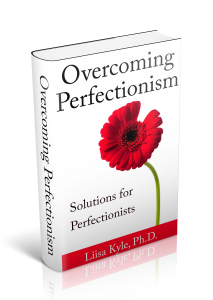 For a comprehensive approach to Overcoming Perfectionism, check out my book, available in hardcover, paperback & eBook formats here: http://bit.ly/PerfectionismSolutions
For a comprehensive approach to Overcoming Perfectionism, check out my book, available in hardcover, paperback & eBook formats here: http://bit.ly/PerfectionismSolutions
*****
How about you? In the comment box below, please tell us how you know you’re a perfectionist…and/or what’s helped you deal with it.
*****
Want to re-publish this article? Go for it – just include the author’s name, a link to this original post and the following text blurb:
Are you struggling with too many talents, skills, ideas? You may have The DaVinci Dilemma ! Find tools, fun quizzes, coaching, inspiration and solutions for multi-talented people at http://www.davincidilemma.com/ .
! Find tools, fun quizzes, coaching, inspiration and solutions for multi-talented people at http://www.davincidilemma.com/ .
August 1, 2024
How Balanced is Your Life?

By Saffron Blaze [CC BY-SA 3.0 (https://creativecommons.org/licenses/...)], from Wikimedia Commons
Balancing different aspects of life — work, play, family, friends and more — is difficult for many people. It’s significantly more challenging for DaVincis — creative people who are also juggling their many talents, projects and ideas. As we see in the vast majority of our coaching clients, Balance is a Top DaVinci Challenge for multi-talented people. This post is the first in a new series of articles devoted to helping DaVincis create, develop and maintain life balance.Let’s begin by taking stock of your current situation.
Self-Assessment: How Balanced is your Life?
1. How satisfied are you with your life?
Let’s begin by creating a picture of your present life. Literally. First, make a list of the life domains that are important to you (e.g. health/fitness, homelife, social, career/professional, learning/education, spiritual, creative expression, travel/adventure/fun, community service, etc.) — this will be different for everyone so select and label the categories to suit your own unique circumstances. Once you’ve created your personalized list of Important Life Domains, rate your satisfaction with each on a scale of 0 – 10 (where ‘0’ means ‘completely dissatisfied’ and ’10’ means ‘extremely satisfied’.
Next, draw a circle. Divide the circle into equal segments, each representing your personalized list of Important Life Domains. It should look like a perfectly portioned pie. Now, draw a line from the middle of the circle to to the top. Divide the line into equal spaces, numbered 0 – 10. The center of the circle represents ‘0’ while the outer perimeter represents ’10’. Half way is ‘5’ and so on. Using this line as a guide, plot your satisfaction scores for each segment. For a clear image of your current life balance, draw a line to join the plot points. If it looks like a circle, your life is beautifully balanced. If it looks lopsided, some Important Life Domains are getting shortchanged. What’s happening in your circle? Which Important Life Domains need some attention?
2. How much time do you give yourself each day? Each week?
(This is meant to be a general, off-the-cuff estimate… however if you feel compelled to do a detailed analysis of your time use, here’s how).
The point is to be honest: Are you giving yourself short shrift? If so, you’re not alone: in coaching corporate executives and successful artists, it’s astonishing how many clients burst into tears when I asked them if they could give themselves twenty minutes a day. Here’s the thing: if you’re not attending to your own needs, you’re not being effective in meeting the needs of everyone else who depends on you.
3. How much time do you spend growing or nurturing your mind each day? Each week?
Your creativity springs from your vibrant imagination. If you’re not attending to your brain, you are curtailing your creativity. Ditto if you are engaging in behaviors known to harm your brain — like overindulging in alcohol.
4. How healthy are you? How much time do invest in maintaining or strengthening your body each day?
The goal is not to look like an airbrushed magazine cover. The goal is health. This is another fundamental ingredient in life balance. When you take good, basic care of your body, you create the energy to do everything else.
5. To what extent do you engage in your preferred spiritual practices?
Whatever the nature of your spiritual beliefs, it’s essential to incorporate the practices you find fulfilling and soothing. It doesn’t matter if it’s a weekly walk in nature or stopping once a day to meditate or observing particular rituals or simply taking a moment to express appreciation for the blessings in your life. To what extent are you finding time and space to nourish your spirit?
6. How well do you sleep? Do you experience any sleep disturbances?
Studies show that optimum sleep patterns for adults is seven hours a night. DaVincis often have so many thoughts pinging around their brains, they often find it tough to fall asleep. Sometimes they wake up in the middle of the night bursting with ideas. When creative people find their mood dipping down, it can trigger over-sleep and unusual difficulty waking up in the morning. Sometimes multi-talented people deprive themselves of sufficient sleep as a way of trying to gain more productive hours in the day. If this becomes a established pattern, it can have long-term consequences for your physical and mental health.
7. In what shape are your finances?
Are you managing your money effectively? How do you feel about money in general — Fear? Anger? Joy? Avoidance? What are your beliefs about wealth? About wealthy people? Financial concerns and beliefs are enormously important in developing a contented, creative life. How are you faring in this aspect of life?
8. How stressed are you?
On a scale of 0 – 10, how stressed are you on an average day? (Where zero means “I’m a human noodle, completely stress-free” and ten means “I’m shaking, frothing and my hair is about to combust”). Stress is inversely proportional to life balance.
9. To what extent are your ideas being heard and developed?
A key element of life balance is making meaningful contributions to each of your Important Life Domains. For each, ask to what extent your ideas are being heard and developed. You may find that your ideas are flourishing at work but that your thoughts at home are being squelched, silenced or otherwise curtailed. To what extent are you giving yourself the time and space to develop your creative ideas?
10. How well do you treat yourself? How do you reward yourself?
These are two different but equally important questions. How you treat yourself determines how others treat you. How you reward yourself (or don’t) affects your motivation and effectiveness.
*****
Activity: Clear some private, uninterrupted time to go through this self-assessment. Answer each of the 10 questions. In which respects are you balanced? In which are you not? Make a list of what’s working well and what isn’t.
*****
Check out my workbook: YOU CAN CHANGE YOUR LIFE: A Workbook to Become the Person You Want to Be. Available here in hardcover, paperback & eBook formats: http://bit.ly/ChangeYourLifeWorkbook*****
If you’d like to share or publish this article, you may, if you include the author’s name, a link to this original post and the following text blurb:
Are you struggling with too many talents, skills, ideas? You may have The DaVinci Dilemma ! Find tools, fun quizzes, coaching, inspiration and solutions for multi-talented people at http://www.davincidilemma.com/.
! Find tools, fun quizzes, coaching, inspiration and solutions for multi-talented people at http://www.davincidilemma.com/.
July 1, 2024
Health Benefits of Creativity

CCO creative commons image via pixabay
For a while there, I was quite worried about my husband’s health. He was not eating healthfully, exercising, or sleeping well. He was stressed out, sedentary, and generally not delighted. I was concerned.
Then, out of the blue, he got back into photography. This was once a happy passion of his — but one, sadly, he had shelved for the past few years. Thankfully, as soon as he started taking photos again, his whole energy changed. He happily planned local excursions to shoot new material. He deep-dived into researching new technology and techniques for shooting, editing, and printing. He shifted his schedule to include some photography time every day. His smile reappeared, as did a spring in his step. His transformation reminded me just how important creativity is to our health and well-being.
You’ve probably seen in it your own life: when you are create, you are healthier. You have more physical and mental energy. Your mind works faster. Your mood is elevated. You sleep better. You take better care of yourself. Compare this to how you feel when you are not creating: your energy is lower. You are more sluggish in mind and body. You are probably crankier and more pessimistic. Your sleep is likely to be disrupted. You may self-medicate with booze or junk food or random chemicals.
Research supports our anecdotal experiences. Creativity can lower heart rate, blood pressure and levels of stress hormone. Scientific studies have proven the therapeutic effects of crafting in managing pain, alleviating stress, reducing depression, and enhancing cognitive functioning. This literature review summarizes the research that has chronicled many mental and physical benefits of expressing creativity through music, visual arts, movement, and writing.
These studies reinforce what many of us have experienced: Creativity elevates our mood and reduces stress. When we create, we take better care of ourselves. Let’s dive deeper.
Creativity elevates our mood and reduces stress.
First and foremost, creative expression is an instant mood lifter. It’s fun. It feels good. It makes us happy. When we get in ‘the zone’, our minds and bodies relax. Our neurons emit happy endorphins producing euphoria and blocking pain. (How do dancers dance on broken toes? Endorphins.)
Let’s compare that to what happens when stress hormones such as cortisol are emitted by our cells. In the short term, stress hormones are very helpful and essential to our nature. They allow us the physical capacity for ‘fight or flight’ on the spot. They instantly amp up our fear. They divert energy towards our limbs and circulation while suppressing immune, digestive, reproductive and growth systems. This is wonderfully helpful if we need to, say, fight off a shark attack or run away from a bear.
These biological responses are also triggered by modern day stresses like the bosses’ random demands, commuting, paying bills, and so forth. The body detects our stress and tries to help. The problem is that, unlike shark attacks which are relatively brief, modern stressors persist. When stress persists, our biological responses persist, too. Our fear remains amped up. Our immune, digestive, reproductive and growth systems remain suppressed. The longer this state persists, the greater the damage to our bodies and our health.
One way to curtail the ravages of stress hormones is by meditation. Taking a few 3-4 minute meditation breaks in the day can be enough to disrupt and offset stress.
Much as I enjoy and appreciate meditation, it can be challenging to commit to a regular meditation practice. And frankly, it’s not exactly exciting. A more fun way to offset stress is to create.
The more time we spend creating, the more endorphins we release, the happier we are and the less stress hormones we emit.
But here’s a caveat: if you create for a living, you may find your creative process has been infiltrated by all kinds of stress-producing elements. The budget! The stakeholders! The critics! All these pressures can curtail the health benefits of your creative endeavors.
To the extent you can focus on the creative aspects of your job, rather than the practical, the healthier you will be.
To do this, you need to first, monitor your stress level i.e,. pause and take note, several times a day. Second, you need to take action accordingly. If you are feeling happy and relaxed, carry on. If, however, you are stressed or brooding or unhappy, pause and problem solve: Do you need a break? Do you need help? Do you need a different approach? What is REALLY the problem: the situation or your fears or feelings about it? What is solvable?
What can you put in place to monitor and curtail your stress level? Some people find it helpful to wear a FitBit or other bio-monitoring device. Some prefer to pause a few times a day to check their mood and stress level, and then take action accordingly. Some make a point of inserting stress-reducing activities into their day.
***
Activity: How can you monitor your stress level, several times a day? Take a moment to think about what will work for you, given your unique circumstances and preferences. Make a list. Pick (at least) one. Now make a point of implementing it this week.
***
Alternatively, what creative expression do you enjoy, outside of work? This is where DaVincis — multi-talented people — have a real advantage in life. Most of us have many creative pursuits, some of which are caught up in our identify and livelihood, and some of which are not. The latter can heal the stress induced by the former.
For example, as much as I love writing, it is woven up in practical factors such as my career and my identity as an author. I do adore making silver jewelry but I sometimes fret about the commercial appeal and distribution of my creations. In contrast, I feel no such tangles with other creative pursuits I enjoy such as making tapestries or crafting birthday cards or mucking about with acrylic paints. These are happy diversions done simply for the fun of it.
***
Activity: What creative pursuits do you enjoy just for fun? (Ideally these would be activities that have little or no connection to your personal identity or to your livelihood). Make a list. Of these, which are easy and fun for you to engage in most days? If you don’t already, make a point of indulging in some purely fun creative activities this week. Even a half hour a day, several times a week can give you a huge mood boost.
***
The important thing here is to start. To establish a habit of inserting stress-free creative expression into your regular week. Another way to do this is to sign up for a class. You could learn a new skill or hone existing talents. The advantage of a class is that it is a regular appointment with you and your talents. As well, it’s a change to connect with like-minded others. Or maybe you prefer to teach a class. Or to set up a self-directed study via the internet. Whatever works for you to establish a routine of regular creativity.
Once you have regular opportunities for creativity in your life, your mood will life and your stress will decrease. And you will gain other health benefits pretty easily:
When we create, we tend to take better care of ourselves.
We eat better. We give our body some attention. We lay off the booze or potato chips or chemical forms of self-medication.
Take a moment to think about what easy things you could do to improve your health. Make a list. (If you want some ideas, here are some). Now, pick one thing to implement this week. Once that becomes a regular habit, go back to your list and choose another idea. Implement it.
Why bother?
The healthier you are, the more you will fuel your creativity. The more creative you are, the healthier you will be.
***
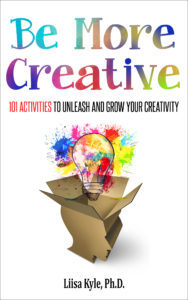 Check out my workbook: BE MORE CREATIVE: 101 Activities to Unleash & Grow Your Creativity
Check out my workbook: BE MORE CREATIVE: 101 Activities to Unleash & Grow Your Creativity
Available here in hardcover, paperback & eBook formats: http://bit.ly/BeMoreCreativeBook
***
If you’d like to share or publish this article, you may, if you include the author’s name, a link to this original post and the following text blurb:
Are you struggling with too many talents, skills, ideas? You may have The DaVinci Dilemma ! Find tools, fun quizzes, coaching, inspiration and solutions for multi-talented people athttp://www.davincidilemma.com/.
! Find tools, fun quizzes, coaching, inspiration and solutions for multi-talented people athttp://www.davincidilemma.com/.
June 1, 2024
The Threat of ‘Triple Threats’

By PeterPan23 [Public domain], via Wikimedia Commons
Are you a ‘Triple Threat’ — someone who is overtly talented in three skills? Maybe you’re a singer/dancer/actor. Or an inventor/engineer/marketing guru. (I’ve even met a writer/pastor/master gardener). If you excel at multiple things, be aware: you may be scaring people. It’s not deliberate. You are just doing things you love that you are good at — but you may be inadvertently posing a threat to other. Without meaning to, you might be making others feel jealous or inadequate or less than competent.This is one of the stickiest challenges faced by a DaVinci — someone juggling many talents, projects, and ideas: How to enjoy, develop, and succeed in multiple arenas, regardless of others’ reactions.
If you have more than one skill, you’ve no doubt experienced a range of reactions to your talents. Sure, some people are appreciative and supportive. Yet others might be uncomfortable.
It doesn’t make logical sense: whatever you’re doing should have no bearing on how others view themselves. But it often does. Most notably among those prone to jealousy or competitiveness or self-doubt. A scathing review may have more to do with the author’s own issue of self-worth than what you’ve actually done.
Now it’s one thing to receive a cold shoulder or some polite distance or a hurtful review. (Or worse, a mediocre review. “Meh. It’s okay, I guess”). These negative reactions can be especially challenging when expressed by someone is close to you. I’ve coached countless DaVincis who have suppressed or avoided talents, lest they overshadow a sibling or parent or spouse. What a sad irony! To miss out on something you love to avoid ‘hurting’ someone you love.
Now some will say — “Hey, if they really love you, they’ll want you to express your talents.” Sure, at some level. But at other — probably subconscious — levels, they may be exuding pain or disappointment in themselves and it’s natural for you to want to spare them that.
For example, you may end up focusing on other skills that the person doesn’t share, so there’s no implicit comparison or inadvertent competition. One of my clients is very musical but he specifically avoided learning the instrument his older sister played.
So what’s a Triple Threat to do?
1. Be aware.
As a Triple Threat, know that you can irritate or scare others. Be sensitive to your impact on others. Be kind. Avoid trying to impress others. Avoid undue pride, arrogance, or obnoxiousness.
Be prudent in how you share your talents, under what circumstances, with whom. Just as you don’t tell strangers your entire life story, nor does it make sense to blurt out descriptions of your every skill, project, and accomplishment in one fell swoop. Allow different aspects of yourself to be revealed, as makes sense under the circumstances.
Let passion be your motivator, rather than external validation: Come from a place of ‘This is what I love to do’ instead of ‘This is going to knock their socks off!’.
2. Recognize what’s happening.
Understand that people are going to respond to your talents in random ways that may have very little to do with you. Their reactions might be more indicative of their own self-worth or comfort in their own skin or even the kind of day they’ve had.
3. Savor the positive.
When you do receive true appreciation or support for your talents, be grateful. It’s rare.
4. Minimize the negative.
Haters gonna hate. Trolls are gonna troll. Jealous people are gonna be jealous. Competitive people are going to see gauntlets everywhere they look. There is NOTHING you can do to prevent these reactions. What you CAN do is minimize the impact they have on you.
Is there any worthwhile kernel of helpful feedback in what they are saying? If so, accept it. If not, put it aside and move on.
5. Involve people you care about.
If you are experiencing a negative reaction from someone important to you, see if there’s a way to comfortably involve them in what you’re doing. Does it make sense to ask for their input? Is there some role they can play? Is there a way they can contribute to your endeavors? Alas, this isn’t always possible but when it is, proven way to transform negative vibes into something much more positive. Maybe even helpful.
One challenge of being a DaVinci is finding ways to share your talents comfortably with others — and managing negative reactions when they arise. What’s worked well for you in the past? What hasn’t? What else might you try going forward? How can you use your creativity to devise new ways to manage the ‘threat’ that sometimes comes with being a ‘triple threat’?
*****
For more, check out my workbook: SELF-WORTH ESSENTIALS: A Workbook to Understand Yourself, Accept Yourself, Like Yourself, Respect Yourself, Be Confident, Enjoy Yourself, and Love Yourself. Available here in hardcover, paperback & eBook formats: http://bit.ly/SelfWorthEssentials*****
Want to re-publish this article? Go for it – just include the author’s name, a link to this original post and the following text blurb:
Are you struggling with too many talents, skills, ideas? You may have The DaVinci Dilemma ! Find tools, fun quizzes, coaching, inspiration and solutions for multi-talented people at
http://www.davincidilemma.com/
.
! Find tools, fun quizzes, coaching, inspiration and solutions for multi-talented people at
http://www.davincidilemma.com/
.
May 1, 2024
Fulfillment

By Garry Knight from London, England (Gentle Exercise) [CC BY-SA 2.0 (https://creativecommons.org/licenses/...)], via Wikimedia Commons
You’re smart. You’re creative. You’re juggling many talents, projects, and ideas. Are you fulfilled? To what extent are your activities meaningful? To what extent are you content and gratified? Are you enjoying your life and your talents? Are you getting things done?What is Fulfillment?
Based on my fifteen years coaching people and groups, I’ve developed a model of fulfillment. It consists of three overlapping components:
Doing something of value. Something meaningful. Making a contribution to the world, to your family, to your company, and/or to yourself.Being satisfied, content, gratified. Doing something that makes you happy or brings you joy.Getting things done. Completion. Accomplishment. Achievement.When something gives us two of these elements, it feels that much better. When something gives us all three, it is fully fulfilling.
***
Activity: Take a few moments to make three lists:
* What makes you happy?
* What gives you meaning?
* What are you accomplishing?
Circle any item that you’ve put on all three lists: this is the key to your fulfillment.
***
We are aware of our fulfillment at different levels:
* in life in general
* in our professional activities
* in our personal life (domestic, social, romantic, physical/fitness, learning/education/personal growth, spiritual)
* in our creative endeavors
Self-Assessment
Complete the following chart. On a scale of 1 – 10, to what extent are you:
In My Personal lifeIn My Professional ActivitiesIn My Creative EndeavorsIn My Life, OverallDoing things that are meaningful/ valuable to me Doing things that are meaningful/ valuable to othersFeeling satisfied/ gratified/happy/ joyGetting things done; accomplishing things; achieving thingsWhat patterns do you see?
What implications are there for your present fulfillment?
What insights are there for your future fulfillment?
Your highest numbers indicate those aspects of your life that give you the most fulfillment. Your lowest numbers indicate areas that offer opportunities to feel more fulfilled, going forward.
For example, imagine if your work is meaningful to yourself and others and gives you joy…but you’re not accomplishing much. Any efforts you can put into figuring ways to get things done will enhance the fulfillment you feel.
If your personal life is rich and happy but your professional life is not satisfying, then what opportunities are there to enrich your professional life?
Once you have a snapshot of what gives you meaning, joy, and accomplishment in your life — and what doesn’t — you can take steps, accordingly. You can give more attention to those things you find meaningful or gratifying. You can get more done. You can give less attention to things that are unimportant or unpleasant or unproductive. You can nudge yourself towards a more fulfilled life.
*****
Check out my workbook: YOU CAN CHANGE YOUR LIFE: A Workbook to Become the Person You Want to Be. Available here in hardcover, paperback & Ebook formats:http://bit.ly/ChangeYourLifeWorkbook*****
Want to re-publish this article? Go for it – just include the author’s name, a link to this original post and the following text blurb:
Are you struggling with too many talents, skills, ideas? You may have The DaVinci Dilemma ! Find tools, fun quizzes, coaching, inspiration and solutions for multi-talented people at
http://www.davincidilemma.com/
.
! Find tools, fun quizzes, coaching, inspiration and solutions for multi-talented people at
http://www.davincidilemma.com/
.
April 2, 2024
Sit! Stay!

By Burty1 at en.wikipedia [Public domain], from Wikimedia Commons
Do you procrastinate? Do you have difficulty getting started? Once you’re doing something, are you easily distracted? Here’s an easy, two step technique to help you focus and make progress. It works with domestic chores, professional activities, creative endeavors, studying, exercising…pretty much any activity.Step One: Sit.
By ‘sit’ I mean, “situate yourself as if you were about to begin”. You might be sitting, you might be standing there amid your welding gear or trotting down the street, flagging a taxi to an important meeting. Put yourself in whatever position you need to be to commence whatever it is you want to do.
Step Two: Stay.
Okay, actually this is a multi-part step. First, decide on what would be a reasonable, do-able period of time to commit your focus to the task at hand — and ONLY the task at hand. This might be fifteen minutes of housecleaning or twenty minutes of making follow-up calls or thirty minutes walking on a treadmill or fifty minutes of writing or an hour of studying. What sounds like a good time frame, given whatever it is you want to do? Note: If in doubt, pick a shorter length of time.
Now: remove all distractions, to the extent possible. Commit to focus ONLY on the task at hand for the period of time you’ve chosen.
Set a timer.
Once the timer is ticking, begin.
Keep going until the timer turns off.
Warning: your monkey mind may try to hijack you during your period of focus. It’s as if your brain is a naughty child who suddenly needs your attention, simply for the sake of getting your attention. Don’t let it! If a distraction pops up the midst of what you’re doing, defer it until the end of your chosen time period. If you suddenly think of a great idea, quickly jot it down, then resume what you were doing. If you suddenly remember you forgot to do something, defer it until the timer goes off. (Hey, you’re already late, what’s a few more minutes?).
Do whatever you have to to keep focus on your chosen task for the entire time you’ve selected. Give yourself the experience — and pleasure — of doing what you set out to do. It feels good! Action feels much, much better than procrastination. And odds are high, you’ll keep going after that initial period. This is because once we get moving, it’s easier to keep going.
It’s up to you: when the timer does go off, you can either pause or keep going. You can take a break and then repeat the process. You can make it a daily practice.
This is such a simple technique and I’ve found it works with many different people trying to do myriad activities, under countless circumstances. There’s something about a timer than compels us to take action. Once we do so — once we actually start, we’ll actually make progress.
Trouble shooting: If you try this technique and don’t keep your focus on the task at hand for the entire time period, pick a shorter time period and try again. It may take a bit of trial and error to find the rhythm that words best for you.
Variation: Sit! Stay! Play!
If you’d like to make this technique a regular practice, here’s a suggested enhancement: do your activity for your chosen amount of time, then immediately reward yourself with some guilt-free play. (e.g. stretch, walk, have a cup of tea, read, listen to some music, meditate whatever would be a good break for you). Then repeat.
It’s up to you to find the Sit / Stay / Play pattern that works best for you given what you’re trying to do, your circumstances, and your preferences. What periods of time for work and for play? When? How often? Some people like to structure their days with Sit/ Stay / Play periods scattered throughout. Others like to distribute them throughout their week e.g. one Sit / Stay/ Play period per day, at least four times a week.
It’s also up to you to determine what “play” would be fun and rewarding — without causing other challenges. Play might include things like stretching, meditating, mindful eating, physical activity (yoga, jumping jacks, crunches or walking around the block), petting the dog, listening to a great song or simply lying down and resting your brain briefly. Things that are pleasant, peaceful and a change from your major activity are ideal – and this will be unique to you and the task at hand. Writers need to take a break from sitting at the keyboard whereas dancers need to rest their bodies. Musicians may need some quiet time whereas actors may need to do the hokey-pokey.
Less likely to be successful as ‘play’ might things like shoveling unhealthy food into your gullet while maniacally surfing the ‘net while trimming your toenails. Any multi-tasking, any stressful activity (like calling the cable company) or things difficult to stop after just five minutes (e.g. napping or computer Scrabble or chatting with a friend) should be avoided. Again, this is highly individualized. For example, ten minutes of internet surfing might be a nice ‘play’ activity after fifty minutes of writing for some people… but not a good choice for a web info junkie who can’t stop after ten minutes. If you find your “play” time is leaking into your Sit / Stay time, or causing other distractions, pick something else.
* * *
Activity: What would be good ‘play’ activities for you? Make a list of ten pleasant, healthy things you could do as a 5 – 10 minute treat between blocks of focused activity.
Now: Make a list of ten things that would NOT be ‘good play for you – things that are stressful or unhealthy or addictive i.e. likely to spill over into the next hour.
* * *
This week, try the Sit / Stay / Play method. Experiment to see what schedule or pattern works well for you. Let us know how you do – message us or leave a comment below.
***
For more, check out my book LIFE LEVERS: Make Small Changes to Create Big Improvements in Your Life
Available here in hardcover, paperback & eBook formats: http://bit.ly/LifeLevers***
Want to re-publish this article? Go for it – just include the author’s name, a link to this original post and the following text blurb:
Are you struggling with too many talents, skills, ideas? You may have The DaVinci Dilemma ! Find tools, fun quizzes, coaching, inspiration and solutions for multi-talented people at http://www.davincidilemma.com/ .
! Find tools, fun quizzes, coaching, inspiration and solutions for multi-talented people at http://www.davincidilemma.com/ .
March 1, 2024
The New “Normal”

By mproopesh [CC BY-SA 3.0 (https://creativecommons.org/licenses/...)], from Wikimedia Commons
What’s “normal“? Anything you want it to be. These days — thanks to technology, globalization, and the waning of past cultural or societal traditions — you have the potential to live and work however you choose. You can take on whatever projects are meaningful to you. You can arrange your living situation, activities, and schedules accordingly. You can decide how you present yourself to the world — in thought, word, deed, and appearance. You can create your own, unique version of “normal”. To the extent you do so, the happier and more fulfilled you can be.How does that sounds to you? How do you react when you consider that you can live your life any way you want? If you are excited about the prospects, please go do something about it right now.
If, however, you are skeptical — or fearful — or overwhelmed, please read on:
Let’s put things in context. Once upon a time, people living in a common environment were expected to live similar lives. It made sense that people inhabiting a given location would eat similar things, dress similar ways, and behave alike. For one thing, there were common, often limited, resources that restricted diversity within a given group. Over time, the group, itself, would impose overt and subtle pressures to conform to societal norms and expectations. This created first tribal, then national, customs and traditions.
As the world continued to turn, people became exposed to varied environments, societies, and options. The more people explored, the more they became familiar with different ways other people lived — and the more options infiltrated into the cultural consciousness. The more technology has advanced, the faster new options have been generated, the swifter they have been communicated, and the more they’ve multiplied. These days, people have an unprecedented range of possibilities available — in every area of life.
The bottom line for DaVincis is that we can use these rapid, myriad changes to our advantage. We can pursue our multiple passions for fun and profit. We can let our freak flag fly. We can create our own, unique version of “normal”.
Take a few moments to ask yourself: What is fulfilling and gratifying for you? What’s important? What’s fun? What’s pleasant? What makes life worth living? How can you utilize your unique talents to create a life you love?
Once you sort out your current priorities, consider logistics: given you your unique circumstances, preferences, and talents, how can you implement your own, unique New Normal?
Answering this may require research, creative problem solving, and trial-and-error. Keep an eye out for options and inspiration. As you implement changes, pay attention to what works well and what doesn’t. What adjustments can you make going forward so that you are moving towards your preferred ‘New Normal’?
Next, how will you prepare yourself for the challenges that will arise?
The number one thing getting in the way of your New Normal is likely to be fear. Beyond that, you may face challenges in time management, organization, staying on task and getting things done. Procrastination and perfectionism are issues that may arise — not to mention life/work balance.
It’s up to you to find and implement solutions tailored for your unique talents, circumstances, and preferences. As multi-hyphenates who are well familiar with all these challenges, Lisa Rothstein and I co-founded The DaVinci Dilemma (TM) — to help you do just that. As you browse our articles and books, you will find dozens of ideas, tips, techniques and strategies so you can create the New Normal that’s right for you.***
Want more? Check out my book YOU CAN CHANGE YOUR LIFE
Available here in hardcover paperback & eBook formats: http://bit.ly/ChangeYourLifeWorkbook
***
Want to re-publish this article? Go for it – just include the author’s name, a link to this original post and the following text blurb:
Are you struggling with too many talents, skills, ideas? You may have The DaVinci Dilemma
! Find tools, fun quizzes, coaching, inspiration and solutions for multi-talented people at http://www.davincidilemma.com/ .

